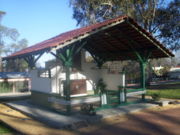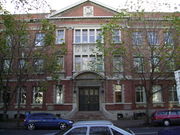Michael Woodruff
2008/9 Schools Wikipedia Selection. Related subjects: Human Scientists
| Michael Woodruff | |
 |
|
| Born | 3 April 1911 |
|---|---|
| Died | 10 March 2001 (aged 89) |
| Nationality | |
| Fields | Organ transplantation |
| Institutions | Universities of Sheffield, Aberdeen, Otago, Edinburgh |
| Alma mater | University of Melbourne |
Sir Michael Francis Addison Woodruff FRS FRCS ( 3 April 1912 – 10 March 2001) was an English surgeon and scientist principally remembered for his research into organ transplantation. Though born in London, Woodruff spent his youth in Australia, where he earned degrees in electrical engineering and medicine. Having completed his studies shortly after the outbreak of World War II, he joined the Australian Army Medical Corps, but was soon captured by Japanese forces and imprisoned in the Changi Prison Camp. While there, he devised an ingenious method of extracting nutrients from agricultural wastes to prevent malnutrition among his fellow POWs.
At the conclusion of the war, Woodruff returned to England and began a long career as an academic surgeon, mixing clinical work and research. Woodruff principally studied transplant rejection and immunosuppression. His work in these areas of transplantation biology, led Woodruff to perform the first kidney transplant in the United Kingdom, on 30 October 1960. For this and his other scientific contributions, Woodruff was elected a Fellow of the Royal Society in 1968 and made a Knight Bachelor in 1969. Although retiring from surgical work in 1976, he remained an active figure in the scientific community, researching cancer and serving on the boards of various medical and scientific organizations. He died on 10 March 2001, at the age of 89.
Early life
Michael Woodruff was born on 3 April 1911 in Mill Hill, London, England. In 1913, his father, Harold Woodruff, a professor of veterinary medicine, moved the family to Melbourne. The Woodruffs did briefly return to London during World War I, but Michael and his brother went back to Australia in 1917 after their mother, Margaret, died. The two then spent a short time under the care of an aunt before being rejoined by their father.
Other than his time in London and a single year in Paris, Michael spent all of his youth in Australia. Staying close to his family, he attended both primary and secondary school in the Melbourne area, and enrolled in the University of Melbourne for his post-secondary education. At the university, Woodruff studied electrical engineering and mathematics, receiving some instruction from the influential physicist Harrie Massey.
Despite success in engineering, Woodruff decided that he would have weak prospects as an engineer in Australia. So, after graduating in 1933, he entered the medical program at the University of Melbourne. While at the University, he passed the primary exam for the Royal College of Surgeons in 1934. He finished the program in 1937 and received an MBBS with honours as well as two prizes in surgery. After graduation, he studied internal medicine for one more year, and served as a house surgeon at the Royal Melbourne Hospital.
World War II
At the outbreak of World War II, Woodruff joined the Australian Army Medical Corps. He stayed in Melbourne until he finished his Master of Surgery Degree in 1941. At that time, he was assigned to the Tenth Australian Army General Hospital in Malaya as a captain in the Medical Corps. However, after the attack on Pearl Harbour, a Japanese offensive resulted in his capture.
After being captured, Woodruff was imprisoned in the Changi Prison Camp. In the camp, Woodruff realized that his fellow prisoners were at great risk from vitamin deficiencies due to the poor quality of the rations they were issued by the Japanese. To help fight this threat, Woodruff devised a method for extracting important nutrients from grass, soya beans, rice polishings, and agricultural wastes using old machinery that he found at the camp. Woodruff later published an account of his methods through the Medical Research Council titled "Deficiency Diseases in Japanese Prison Camps".
At the conclusion of World War II, Woodruff returned to Melbourne to continue his surgical training. During his studies, he served as the surgical associate to Albert Coates, and met Hazel Ashby. Ashby, a science student, made a great impression on Woodruff, and he married her in 1946.
Early career
Soon after his marriage, Woodruff decided to travel to England in order to take the second half of the FRCS Exam. Before departing, he applied for a position as a Tutor of Surgery at the University of Sheffield, and learned en route that the University had accepted his application. He took the FRCS exam in 1947 and passed, perhaps aided by the fact that one of his examiners, Julian Taylor, had been with him at Changi.
Sheffield
After passing his exam, Woodruff entered his position at Sheffield. Originally, he had planned to do surgical research, but Sheffield had no space for him in its surgical lab. Instead, Woodruff was given a place in the pathology laboratory where he studied transplant rejection, a process in which the immune system of a transplant recipient attacks the transplanted tissue. Woodruff was particularly interested in thyroid allografts to the anterior chamber of the eye because they did not appear to meet with rejection.
Woodruff's work with the allografts gave him a solid basis to work in the developing field of transplantion and rejection. To further himself in these areas, Woodruff arranged to meet Peter Medawar, an eminent zoologist and important pioneer in the study of rejection. The two men discussed transplantation and rejection, beginning a lasting professional relationship. Despite his achievements at Sheffield, Woodruff was rejected upon applying for a post at the Royal Melbourne Hospital.
Aberdeen
In 1948, shortly after applying for the position in Melbourne, Woodruff moved from Sheffield to the University of Aberdeen where he was given a post as a senior lecturer. At Aberdeen, Woodruff was given better laboratory access. He took advantage of this access and his wife's skills as a lab assistant to investigate in utero grafts (tissue grafts performed while the recipient was still in the womb). At the time, the surgical community hypothesized that if a recipient were given in utero grafts, he would be able to receive tissue from the donor later in life without risk of rejection. Woodruff's experiments with rats, however, produced negative results.
While in Aberdeen, Woodruff also visited the United States on a WHO Traveling Fellowship. During the visit, he met many of the leading American surgeons, an experience that increased his own desire to continue his work and research. After returning from the US, Woodruff experimented with the effects of cortisone and the impact of blood antigen on rejection. As part of his blood antigen studies, Woodruff found two volunteers with identical blood antigens and arranged for them to exchange skin grafts. When the grafts were rejected, Woodruff determined that rejection must be controlled by additional factors.
Dunedin
In 1953, Woodruff moved to Dunedin to take up a position as the Chair of Surgery at the University of Otago Dunedin School of Medicine, New Zealand's only medical school at that time. While in Dunedin, Woodruff conducted research on the use of leucocytes (white blood cells) to increase tolerance for allografts in rats. This line of research proved to be largely unsuccessful, but some of Woodruff's other projects did well. Among his more important accomplishments in the period, Woodruff established a frozen skin bank for burn treatment and worked on the phenomenon known as runt disease ( graft versus host disease).
Edinburgh
In 1957, Woodruff was appointed to the Chair of Surgical Science at the University of Edinburgh. At the university, he split his time equally between his clinical and teaching responsibilities and his research. As a major part of his research, Woodruff served as the honorary director of a Research Group on Transplantation established by the Medical Research Council.
The research group's principal investigations concerned immunological tolerance (the body's acceptance of tissues, as opposed to rejection), autoimmune haemolytic anaemia (especially in mice), and immune responses to cancer in various animals. In his clinical role, Woodruff started a vascular surgery program and worked with the use of immunotherapy as a cancer treatment. However, his most important clinical accomplishments were in kidney transplantation.
Most notably, he performed the first ever kidney transplant in the UK, at the Edinburgh Royal Infirmary. Woodruff had been waiting for the right patient for some time, hoping to find a patient with an identical twin to act as the donor, as this would significantly reduce the risk of rejection. The patient that Woodruff eventually found was a 49-year-old man suffering from severely impaired kidney function who received one of his identical twin brother's kidneys on 30 October 1960. That same year, Woodruff published The Transplantation of Tissues and Organs, a comprehensive survey of transplant biology and one of seven books he wrote.
Woodruff retired from the University of Edinburgh in 1976 and joined the MRC Clinical and Population Cytogenetics Unit. He spent the next ten years there, engaged in cancer research with an emphasis on tumor immunology. During that time, Woodruff also published twenty-five papers and two books. After retiring from his cancer research, Woodruff lived quietly with his wife in Edinburgh, traveling occasionally, until his death there on 10 March 2001 at the age of 89.
Legacy
Woodruff's contributions to surgery were important and long-lasting. In addition to performing the first kidney transplant in the UK, he devised a method of implanting a transplanted ureter in the bladder during transplants that is still used today. Furthermore, he established a large, efficient transplant unit in Edinburgh that remains one of the world's best. Although best known for these clinical accomplishments, Woodruff's contributions to the study of rejection and tolerance induction were equally important. Among these contributions, Woodruff's work with anti-lymphocyte serum has led to its wide use to reduce rejection symptoms in organ transplant recipients up to the current day.
These important contributions to medicine and biology were first seriously honored in 1968 when Woodruff was elected to be a Fellow of the Royal Society. The next year, 1969, Woodruff was knighted by the Queen, a rare accomplishment for a surgeon. Additionally, numerous medical organizations gave Woodruff honorary membership, including the American College of Surgeons, the American Surgical Association, and the Royal College of Physicians of Edinburgh. Woodruff also held office in several scientific organizations, serving as Vice-President of the Royal Society and President of The Transplantation Society. Finally, Woodruff served for many years as a WHO advisor and as a visiting professor at a number of universities.
Publications
Woodruff's impact is also apparent in his large volume of publications. In addition to authoring over two hundred scholarly papers, Woodruff wrote seven books during his career, covering numerous aspects of medicine and surgery.
- Deficiency Diseases in Japanese Prison Camps. M.R.C Special Report No. 274. H.M. Stationary Office, London 1951.
- Surgery for Dental Students. Blackwell, Oxford. (Fourth Ed., 1984 with H.E. Berry) 1954.
- The Transplantation of Tissues and Organs. Charles C. Thomas. Springfield, Illinois 1960.
- The One and the Many: Edwin Stevens Lectures for the Laity. Royal Society of Medicine, London 1970.
- On Science and Surgery. Edinburgh University Press, Edinburgh 1976.
- The Interaction of Cancer and Host: Its Therapeutic Significance. Grune Stratton, New York 1980.
- Cellular Variation and Adaptation in Cancer: Biological Basis and Therapeutic Consequences. Oxford University Press 1990.


